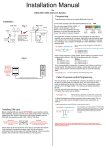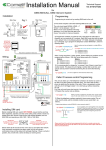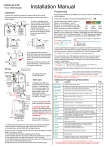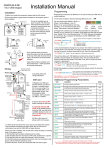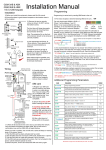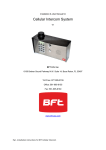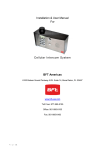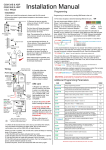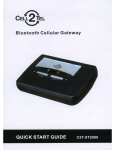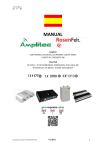Download Manual
Transcript
GSM-3V/AB & ABK V3.5 (1200 keypad) Installation Manual Wiring Important Notes: 1) Before you install this equipment, please read this full manual. 8) Carefully follow the wiring instructions. 2) Before fully installing the system on site, it is recommended that the system be set up on a workshop bench, with SIM card installed and function tested with the customers phone to check everything works ok BEFORE going to site to install it. Antenna connector. Finger tighten only! close RL1 Reset button It is recommended to have a minimum of 5Mbps download speed and 1.5Mbs upload speed. +12-15V d.c. GND Output 2 This app also shows the direction of the cell tower that the phone is connected to. This should help in deciding antenna location, and for directional antennas, it will indicate the direction it should be pointed in. Speech Unit 200mm min Install 4-5 feet from ground Entrance Pillar Side View 5) Install the antenna as high as possible on the top of the pillar to ensure line of sight in all directions for best possible reception. Keep antenna high as possible, and above electronics & audio equipment to eliminate interference Ensure the speech panel is located at an appropriate height in order to have a good view of a visitor when standing in front of it. N/O COM N/C O/P1 inhib Sense (-)GND DU out K or A + - 12-15v d.c. GND 9) Register your SIM card with the network, and check it works in a mobile phone first. If you are using a Prepay or Pay&Go SIM, it will need topped up first. Your SIM should be 3G compatible. 10) Ensure the power is OFF before inserting the SIM card. Advanced keypad functions OUT1 OUT2 Keypad Connections (only keypad models) 12) Check wiring again and switch on power. 13) Allow 20-30 seconds for the unit to boot up and detect the network. The unit should stop bleeping after 10-15 seconds and the GSM led should begin flashing. If there is a fault or problem, the unit will continue to sound error bleeps every 30 seconds. Check… 1) That you have good 3G reception in the area. 1) That the SIM card has been activated and has credit. 2) That the SIM card does not require a PIN code, disable this in a phone. 3) That the SIM card can make and received a call on a phone. 4) If the SIM card was purchased with a phone, that it is not locked to that phone. Call the network operator to check. 5) Switch off power, remove and reseat the SIM card and try again. Wiring Tips.. Connecting DC magnetic lock GSM output Lock Connecting AC/DC strike lock GSM output Lock Connecting automatic gates GSM output Remove only top screws Night illuminator Camera Night illuminator Note: The protective film on the front of the intercom should not be removed until fully installed. Speaker Push Button 7) Use appropriate wall fixings. 8-10mm anchors, 75mm deep with M5 screw are recommended as a minimum. Hinge front door Side View Optional keypad output Separate PSU Optional keypad output Separate PSU Optional keypad output Gate controller Start Com 6) Remove the top two security screws as shown. Do NOT remove the bottom screws. The front door will hinge downwards to allow access for mounting holes and connection terminals. OUT3 Network found 11) Carefully slide the SIM holder in the OPEN direction, insert the SIM, and slide in the CLOSED direction to lock it in place. Do NOT Force or use a screwdriver! INT Lock egress N/O COM N/C N/O COM N/C Now that you have established both good 3G coverage on site, and that the intercom makes a video call to the customer’s phone, you are now ready to install the system. Optional limit switch from gate Tamper N/C Alternatively you can use your standard smart phone display to check the area for good signal strength. A minimum of 3 out of 5 bars is recommended with 3G symbol showing on your notification bar. Installation Output 1 Exit button Standby SIM card AC AC VCC RL2 Busy open GSM modem GND L2 SW2 GND 4) Ensure that there is excellent 3G coverage in your area before you install this system. If in doubt, install an app on your smart phone. We recommend an app called “Opensignal”. Busy = GSM LED = Power LED SIM card holder 3) Please NOTE: iPhones DO NOT SUPPORT 3G VIDEO CALLING! Almost all other leading brands of smart phone do support 3G video calls. Please CHECK your phone can make and receive a video call before installing this system. = CPU LED Programming Additional Programming Parameters Programming is carried out by sending SMS texts to the unit. 1234 The unit should reply SIGNAL LEVEL = ? Where ? will be between 1 and 31 02????# Change access control password (allows users not in caller ID list to call intercom and use pass code to activate relay). 5678 Below 14 can cause problems like intermittent relay operation, no voice from the gate to the house or no video calling. 03????# Change monitoring mode password (dial to listen in mode) 1212 1n*# Delete a button calling number, where n = number 1,2 or 3. N/A 3?# Speaker volume. Where ? = level 0 - 4 3 4?# Microphone volume. Where ? = level 0 - 4 3 50?# Relay 1 time. Where ? = 1-9999 seconds. 1 sec 51?# Relay 2 time. Where ? = 1-9999 seconds. This scale shows the reception grade, from poor to good. It is preferable to be in the top end of medium or higher. 21-31 Good 2) Program the numbers you wish the unit to dial when the call button is pressed, up to a maximum of 3 numbers. Each SMS must start with the pass code, default 1234, in the following format *12*1234#, followed immediately by a command. E.g to program the telephone number 0987654321, enter the following SMS.. *12*1234#1110987654321# Pass code Function code 11 = Telephone number 1 12 = Telephone number 2 13 = Telephone number 3 Data (telephone number) Note: For dialling land lines or non video calling phones, the unit can be programmed to make standard audio calls to certain numbers. 2= Video call 1= Audio call Up to 3 numbers can be sent together in a single SMS as follows.. *12*1234#112tel.number1#121tel.number2#132tel.number3# Note: In this example, the first number is receiving a video call, second number receiving audio call, third number receiving video call. The unit should reply to each programming text sent, with Ok or error message. 3) It is recommended to change the “no answer” time if there is more than 1 number stored. When the unit is calling the first number, and this no answer time expires, then the unit will end the call and begin calling the second number. This can be used to prevent voicemail or answering machines picking up the call on the first number. *12*1234#52??# Where ?? can be 2 digits from 10-99 seconds, default is 20. Note that video calls take around 5-8 seconds to connect. The unit can allow up to 100 telephone numbers to be stored, for users to be able to ring the system for automatic entry. This uses caller ID like a phone to determine the identity of the caller. First, the unit must know what country it is operating in. 4) Program the country code as follows.. *12*1234#71??# Where ?? can be 1-3 digits. For uk, insert 44, for Ireland 353, for USA insert 1. Do not use any leading zeros. 5) Enter the telephone numbers required to have access control. Do not enter country code, just the complete number as you would dial it.. *12*1234#7210987654321# Pass code Function code 72 = Add number Data (telephone number) 1= Relay 1 2 = Relay 2 Default Change programming password. The reply message should show WCDMA. If it only shows GSM, then you do not have 3G coverage. 13-20 Medium Description 01????# 1) First check reception. Send the following SMS to the unit... *20# 1-12 Poor Code Note: As shown, you can pick which relay you wish to activate when dialling in. 3 numbers can be entered in the same SMS. *12*1234#722tel.number1#721tel.number2#722tel.number3# Note: In this example, the first number will trigger relay 2, the second number will trigger relay 1 and the third number will trigger relay 2. USA customers – For some networks, you may need to enter the numbers with the long distance 1 before area code, then the number. E.g. 1-702-555-1234. Try it with and without to see method works. 1 sec 53??# Max call time. Where ??? = 005-999 seconds (3 digit code) 55??# Max monitoring time (for listen in mode when calling the intercom) 00-60 mins. 00 = no limit. 10 min 57??# Unit can call or SMS service number by set duration to prevent SIM card deactivation if seldom used. 00-60 days. 00 = no inform. 00 58?# Choose between scheduled call to service number or send SMS to service number. ?=1 for SMS, 2 for call. 1 77number# Store service number to receive scheduled SMS or call from intercom. N/A 77*# Delete service number. N/A 65?# 73??# Dial in mode for withheld numbers or non stored numbers. 1 = answer the call & wait for pass code. 2 = answer the call, automatically activate 2 way speech & access to relays. Delete phone number for caller ID access, ?? will be the telephone number to be deleted. 60 sec 1 N/A 73*# Delete all phone numbers for caller ID access. N/A 74?# Add engineer phone number. Unit will only accept programming from this number. N/A 74*# Delete administrator phone number. N/A 1?*# Delete a dialling out number, where ? = number location 1,2 or 3. N/A 61?# Change relay 1 trigger code. * 63?# Change relay 1 hold code. # 64?# Change relay 1 un-hold / release code. 1 67?# Change relay 2 trigger code. 7 68?# Change relay 2 hold code. 8 69?# Change relay 2 un-hold / release code. 9 999# Restore defaults N/A Remember to begin each new SMS with pass code *12*1234# Service Commands list These commands do not require a pass code string. Simply send the sms as you see it below... *20# Check reception. Reply will indicate signal level = 0-31 N/A *21# Check stored numbers. Note: no pass code needed for this command. O = dial out number. I = Dial in number. N/A *22# Check gate status. Reply will indicate status of limit switch input (L2), and both relays. N/A Keypad Programming (only ABK models) Restoring defaults LED indicators While in programming mode, enter the following to delete all codes and settings apart from the Master code.. (this can take up to 2.5 minutes)... ON when incorrect codes entered and outputs are locked out. GREEN when output 1 activated. RED when output 2 activated. 9 1 2 3 FAST FLASHING – Wrong code entered / error. 4 5 6 SLOW FLASHING - in normal standby mode. 7 8 9 ON in programming mode. * 0 # ON when relay 3 activated. Enter Programming mode 0 0 0 * The unit is now in programming mode. Amber LED will remain ON. 0000 is default programmers code. Note: Pressing ** again will exit programming mode. * 9 9 # When the master code is forgotten…. 1) Wire a push button (or replicate with wire link) across the EG IN terminal and (-)GND. 2) Switch off power for 1 minute. 3) Switch ON power. 4) during the first 60 seconds, press the EG button once to enable the function. 5) Enter the following code.. Note: Programming can only begin 60 seconds after power on. 0 9 8 0 8 0 * * The keypad should now be in programming mode, ready to accept new data. Enter new programmers code 0 1 ? Location ? ? ? # 4-8 digit code Additional keypad information – Note: These features are not commonly used. Validate EG IN (EGRESS INPUT) Connect a push button between this terminal and (-)GND. When Egress button is pressed, output 1 will be activated for the programmed delay. Egress button is usually located inside a building and used as a push to exit. Record or Delete user codes 1 0 2 10= relay 1 codes (1000 available) 20= relay 2 codes (100 available) 30= relay 3 codes (100 available) 0 0 0 ? ? Memory locations 000-999 for relay 1 001-100 for relay 2 001-100 for relay 3 2= add code 5= delete code ? ? # Pin code 4-8 digits Validate 0 2 Group 2 0 Add code 3 1 5 Location 31 5 5 5 Pin code 5555 # Interlock Output NPN transistor output, open collector, max power 24v dc, 100mA sink. Used to operate a door in conjunction with another keypad, or prevent two doors being opened at the same time. ? 10=relay1 20=relay2 30=relay3 5 ? Delete code ? ? # ID location to be deleted Tamper N/C Normally closed tamper switch. This can be used in conjunction with a tamper switch on a box or enclosure to prevent tampering. This can be connected to an alarm system. Validate Delete all codes in a group ? ? 0 10=relay1 group 20=relay2 group 30=relay3 group 9 9 9 # Super delete code Validate Programming Relay output times & modes ? ? 0 1 or - 9 9 9 9 0 = start / stop toggle mode (latching) 1-99999 = seconds momentary operation 51=relay1 52=relay2 53=relay3 9 # Validate Programming SUPER user code Super user code is an optional feature which allows the same code to operate outputs 1, 2 or 3. 0 O/P 1 Inhibit Normally open. When closed, this disables all codes for relay group 1 except super user and duress codes. Validate Delete a code ? DU OUT (DURESS OUTPUT) An NPN transistor open collector output. It switches to (-) ground after the Duress Code is entered. Use it to trigger an alarm zone, or turn on a buzzer to notify a guard. Ic max: 100mA sink. Vc max: 24VDC DOOR SENSE N/C connected to (-)GND, to be connected to a normally closed door contact. It can be used to generate a door open alarm or door forced open alarm. Example: Add user 31 to have access code 5555 operating relay 2…. 2 K or A. (KEYPAD ACTIVE OUTPUT) An NPN transistor open collector output. It switches to (-) ground for 10 seconds on each key touching. This can be used to turn on lights, CCTV camera, or buzzer to notify a guard. The rating of this output is: Ic max: 100mA sink, Vc max: 24VDC 2 ? Location ? ? ? # 4-8 digit code Validate Using super user code ? ? ? ? # 1 Activate output 1 ? ? ? ? # 2 Activate output 2 ? ? ? ? # 3 Activate output 3 Using standard user code To use standard code, simply enter the 4 digit code. Note: Remember to exit programming mode with ** before testing user codes. User Manual Predator 3G Video Intercom This GSM intercom system will call up to 3 telephone numbers in sequence when the call button is pressed. There are several modes of operation depending on how the unit has been programmed by your installer. The following instructions will assume default programming. Output 1 Intercom calling your phone Press * to trigger relay Press # to hold relay Press 1 to release relay 1 4 7 * 2 5 8 0 3 6 9 # Output 2 Press 7 to trigger relay Press 8 to hold relay END Call button pressed Answer call. Press 9 to release relay (Only some gate systems allow hold open control, depending on manufacturer) Access Control Options Option 1) If your number is saved inside the intercom memory, just dial it and it will activate the door or gate without answering your call. The intercom will end the call for you. Output 1 Dialling… MY GATE END Option 2) If your number is not saved in the intercom memory, it will answer the call. Enter the code on your telephone keypad to activate the door or gate (default code 5678 shown). *33*5678# - Momentary trigger *34*5678# - Hold relay *35*5678# - Release relay Output 2 *36*5678# - Momentary trigger *37*5678# - Hold relay *38*5678# - Release relay Using the Android App If you are using Android, you can purchase the Android app at the google play store (GSM-GATE). The app allows easy advanced control of the intercom and gates or door by the simple press of the buttons shown. The app will need configured with the SIM card phone number of your intercom before it can be used. Once the app is installed, pressing the MENU button on your phone will display the setting screen below, where you can enter the SIM card phone number. If your gate system is set for timed operation where it automatically closes after a preset delay, you may be able to take advantage of the latching features. Press button to trigger gates (speed dials your intercom) Hold open gates (sends latch SMS command) Release / un-hold gates (sends unlatch SMS command) Press for additional features 1) Check gate open or closed 2) Check reception level 3) Check stored numbers Sending SMS Commands All of the features shown on the Android app are also available for non Android users, or non smart phone users. You can simply send the same SMS commands manually to the intercom as detailed below... *33*5678# Momentary trigger output relay (default user pass code 5678) *34*5678# Latch output relay (default user pass code 5678) *35*5678# Un-latch output relay (default user pass code 5678) *20# Check reception level of intercom. *21# Check stored numbers. Unit will reply with list of stored numbers. I = dial in number. O = dial out number. *22# Check gate / door status. Unit will reply Relay1 = On/Off, Relay2 = On/Off, Detect = On/Off SIM cards & Credit Please note that if you are using a Pay&Go or Pre-pay SIM card, which requires topped up occasionally, most network providers provide a feature called Auto Top Up. This allows you to register the SIM card on their web site, and create a payment method. When the credit runs low, the network will automatically top up your SIM card, so that you don’t have to worry about running out. Contact your network provider in your country for more information or register with them online. Fault finding & FAQs Q. The unit will not power up. No LEDs on. A. Check power supply voltage at intercom is within 11.5V-12.5V DC. Cable length from PSU to intercom should be less than 3 meters. Q. The unit powers up but there is a bleeping from the door station. A. This means the unit is not able to detect the network for some reason. -Check the SIM card is activated and has calling credit. -Power off the unit, remove the SIM and check it in a mobile phone to verify it can make a call. -Check the SIM does not ask for a PIN code when put in a phone. If it does, then disable the PIN code request. -Check the SIM is a standard GSM SIM, not 3G or 4G only SIM. If you are unsure, contact your SIM card provider to verify. Frequency of operation should be any one of the international quad band standards, 850 / 900 / 1800 / 1900 MHz. -Check the reception is good. Poor reception is not sufficient. -Check the antenna has been mounted as high as possible, not near large metal objects, or wet green shrubs etc. -Check the antenna connection. Visually inspect that the centre pin inside the antenna is intact, and has not been pushed back inside the fitting. -Check voltage at the intercom is minimum 11.5V and that the cable from power supply to intercom is less than 3 meters. Q. The unit calls the first number, but there is not enough time to answer before it diverts to the next number. A. Increase the no answer time as per programming instructions. Q. The unit calls the first number but voicemail comes on before it can ring the second number. A. Decrease the no answer time as per programming instructions. Q. The caller ID part does not work. A. Be sure to program the caller ID part under 72 feature. If your number is a private or number withheld, then it will not work. Even if you have already programmed a number to receive a call from the intercom, if you also want that number to have caller ID access, it must be programmed under the 72 feature also. Ensure the number is entered as you would normally dial it from another phone. Do not put the country code in front of the number. Enter the country code in which the unit is operating in separate under the 71 feature. International callers ringing the intercom may not work. Q. There is no audio from the gate, but the person at the gate can hear ok. A. This can be due to low reception. -Check reception level by *20#. -Change SIM card if necessary to another network which may have better coverage. -Purchase a high gain antenna. This may also be caused by either a defective microphone. If reception is optimum and the problem persists, contact your supplier or dealer. Q. The audio quality that can be heard on the remote telephone is poor or humming (buzzing). A. A small amount of GSM buzz can be considered normal on GSM intercoms, but not so much that causes inability to hear the person speaking. This can be caused by the GSM antenna being mounted too close to the speech panel or not mounted high enough. -Try earthling the speech panel chassis to 0V of the power supply. -This is also a symptom of poor reception. Try above steps on checking and improving reception. Q. The * or # key does not work when the intercom calls a phone. A. Check if you can hear the relay clicking at the gate when the * or # key is pressed during a call. If it can be heard, then the system is working, check wiring between the relay and the lock or gate panel. If the relays do not make a clicking sound, then check this feature on a different mobile cell phone or landline. If it works on a different phone, check the settings on the phone in question under DTMF tones. Failure of DTMF tones to operate correctly is also a symptom of low reception. Check steps above on improving reception. Try pressing the buttons longer when attempting to activate the gates or door. Q. The intercom makes an audio call but not a video call. A. Check site 3G coverage, check SIM card capability, check that the person receiving the call has a phone that already can receive video calls.





